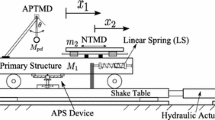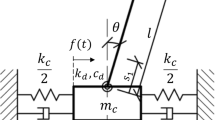Abstract
This work proposes an Itō calculus-based mathematical framework for the optimal design of a nonlinear passive control arrangement. Traditional numerical methods make use of ordinary differential integration schemes to study such nonlinear systems, thereby failing to account for the stochastic nature of the input excitation. Furthermore, such integration schemes require finer time steps for accurate analysis of stochastically excited nonlinear systems, therefore, rendering these schemes to be computationally expensive. Towards this, the present work proposes a new approach employing stochastic differential calculus for the optimal design of a stochastically excited three-dimensional nonlinear pendulum tuned mass damper (PTMD) system. The proposed approach comprises of Itō-Taylor expansion-based framework for deriving the displacement mean-square response of the primary structure. Three different approaches for the determination of the mean-square response are shown. The first approach is based on numerical simulation by employing Itō-Taylor 1.5 integration scheme and the other two premises on the formulation of Itō-Taylor-based mean-square differential equations. The accurate mean-square response obtained from different approaches is then utilised for the optimal design of the PTMD system. The optimal parameters resulted in amplitude reduction of around 75 % in terms of displacement mean-square response and about 85 % at peak frequency. Further, the optimal parameters were utilised to carry out stability analysis of the nonlinear PTMD system.










Similar content being viewed by others
Availability of data and material
Not applicable
References
Den Hartog, J.P.: Mechanical vibrations. Dover Publications, Inc., Mineola, New York (1985)
Rana, R., Soong, T.: Parametric study and simplified design of tuned mass dampers. Eng. Struct. 20(3), 193–204 (1998)
Warburton, G.B.: Optimum absorber parameters for various combinations of response and excitation parameters. Earthquake Eng. Struct. Dynam. 10(3), 381–401 (1982)
Ghosh, A., Basu, B.: A closed-form optimal tuning criterion for tmd in damped structures. Struct. Control and Health Monitor: Official J. Int. Assoc. Struct. Control and Monitor. Eur. Assoc. Control of Struct. 14(4), 681–692 (2007)
Brock, J.E.: A note on the damped vibration absorber. J. Appl. Mech. 13(4), (1946)
Rüdinger, F.: Optimal vibration absorber with nonlinear viscous power law damping and white noise excitation. J. Eng. Mech. 132(1), 46–53 (2006)
Mishra, S.K., Gur, S., Chakraborty, S.: An improved tuned mass damper (SMA-TMD) assisted by a shape memory alloy spring. Smart Mater. and Struct. 22(9), 095016 (2013)
Tiwari, N.D., Gogoi, A., Hazra, B., Wang, Q.: A shape memory alloy-tuned mass damper inerter system for passive control of linked-SDOF structural systems under seismic excitation. J. Sound Vib. 494, 115893 (2021)
Roffel, A.J., Narasimhan, S., Haskett, T.: Performance of pendulum tuned mass dampers in reducing the responses of flexible structures. J. Struct. Eng. 139(12), 04013019 (2013)
Gerges, R.R., Vickery, B.J.: Optimum design of pendulum-type tuned mass dampers. Struct. Design Tall Spec. Build. 14(4), 353–368 (2005)
Colherinhas, G. Bertollucci., Petrini, F., de Morais, M.V.G., Bontempi, F.: Optimal design of passive-adaptive pendulum tuned mass damper for the global vibration control of offshore wind turbines. Wind Energy 2020, 573–595 (2020)
Soltani,P., Deraemaeker, A.: Pendulum tuned mass dampers and tuned mass dampers: Analogy and optimum parameters for various combinations of response and excitation parameters,. J. Vib. Control (2021)
Viet, L.D.: Partial stochastic linearization of a spherical pendulum with coriolis damping produced by radial spring and damper. J. Vib. Acoustics, Trans. ASME 137(5),(2015)
Roffel, A.J., Lourenco, R., Narasimhan, S., Yarusevych, S.: Adaptive compensation for detuning in pendulum tuned mass dampers. J. Struct. Eng. 137(2), 242–251 (2011)
Gogoi, A., Panda, S., Hazra, B.:A computational framework for mean square responses of bidirectional nonlinear systems under correlated stochastic excitation. J. Sound and Vib., p. 116689, (2022)
Kloeden, P.E., Platen, E.: Numerical Solution of Stochastic Differential Equations, vol. 53. Springer, Berlin Heidelberg (1992)
Roy, D., Rao, G.V.: Stochastic dynamics, filtering and optimization. Cambridge University Press, Cambridge, United Kingdom (2017)
Tripura, T., Gogoi, A., Hazra, B.: An Ito-Taylor weak 3.0 method for stochastic dynamics of nonlinear systems. Appl. Math. Model. 86, 115–141 (2020)
Farshidianfar, A., Soheili, S.: Ant colony optimization of tuned mass dampers for earthquake oscillations of high-rise structures including soil-structure interaction. Soil Dyn. Earthq. Eng. 51, 14–22 (2013)
Bekdaş, G., Nigdeli, S.M.: Estimating optimum parameters of tuned mass dampers using harmony search. Eng. Struct. 33(9), 2716–2723 (2011)
Salvi, J., Rizzi, E.: Minimax optimization of tuned mass dampers under seismic excitation, In: EURODYN 2011: 8th International Conference on Structural Dynamics, Leuven, Belgium, 4-6 (2011)
Hadi, M.N., Arfiadi, Y.: Optimum design of absorber for mdof structures. J. Struct. Eng. 124(11), 1272–1280 (1998)
Bhaiya, V., Bharti, S., Shrimali, M., Datta, T.: Genetic algorithm based optimum semi-active control of building frames using limited number of magneto-rheological dampers and sensors. J. Dyn. Syst. Meas. Contr. 140(10), 101013 (2018)
Särkkä, S., Solin, A.: Applied stochastic differential equations, vol. 10. Cambridge University Press, Cambridge, United Kingdom (2019)
Calin, O.: An Informal Introduction to Stochastic Calculus with Applications. World Scientific Publishing, (2015)
Kloeden, P.E., Platen, E., Schurz, H.: Numerical Solution of SDE Through Computer Experiments. Universitext, Berlin, Heidelberg, Springer, Berlin Heidelberg (2003)
Higham, D.J.: An Algorithmic Introduction to Numerical Simulation of Stochastic Differential Equations. SIAM Rev. 43(3), 525–546 (2001)
Cyganowski, S., Kloeden, P., Ombach, J.: From Elementary Probability to Stochastic Differential Equations with MAPLE®. Universitext, Berlin, Heidelberg, Springer, Berlin Heidelberg (2002)
Meirovitch, L.: Methods of Anal. Dynam. McGraw-Hill, (1970)
Socha, L.: Linearization Methods for Stochastic Dynamic Systems. Springer, (2008)
Roberts,J., Spanos, P. D.: Random Vibration and Statistical Linearization. Dover Civil and Mechanical Engineering, (2003)
Matta, E.: A novel bidirectional pendulum tuned mass damper using variable homogeneous friction to achieve amplitude-independent control, (2019)
Soltani, P., Deraemaeker, A.: Pendulum tuned mass dampers and tuned mass dampers: Analogy and optimum parameters for various combinations of response and excitation parameters. JVC/J. Vib. Control, (2021)
Sun, C., Nagarajaiah, S., Dick, A.J.: Experimental investigation of vibration attenuation using nonlinear tuned mass damper and pendulum tuned mass damper in parallel. Nonlinear Dyn. 78(4), 2699–2715 (2014)
Chin, E., Ólafsson, S., Nel, D.: Problems and Solutions in Mathematical Finance : Stochastic Calculus. John Wiley & Sons Inc., (2014)
Bakre, S.V., Jangid, R.S.: Optimum parameters of tuned mass damper for damped main system. Struct. Control. Health Monit. 14(3), 448–470 (2007)
Ghosh, A., Basu, B.: A closed-form optimal tuning criterion for TMD in damped structures. Struct. Control. Health Monit. 14, 681–692 (2007)
Yan, X., Nie, J.: Response of SMA Superelastic Systems under Random Excitation. J. Sound Vib. 238, 893–901 (2000)
Acknowledgements
This work was performed as part of the SEMPRE and WindPearl projects. WindPearl was funded by the Sustainable Energy Authority of Ireland (Project number RDD/00263). The authors acknowledge the support of Science Foundation Ireland Centre Marine and Renewable Energy Ireland (MaREI/R2302_2) and NexSys Centre, grant number 21/SPP/3756, and the UCD Centre for Mechanics. Budhaditya Hazra would like to acknowledge the financial support from SERB, DST, under the Project No. IMP/2019/000276.
Author information
Authors and Affiliations
Corresponding author
Ethics declarations
Conflict of interest
The authors declare that they have no conflict of interest.
Code availability
Some or all code generated or used during the study are available from the corresponding author upon request.
Additional information
Publisher's Note
Springer Nature remains neutral with regard to jurisdictional claims in published maps and institutional affiliations.
Appendices
Appendix A Closed form expression results from mean-square derivation
1.1 A.1 Moment derivatives for approaches #2 and #3
Five of the 55 mean-square derivatives are listed here.
-
1.
$$\begin{aligned} \begin{aligned} \frac{d E[y_1^2]}{dt} = 2 E[y_1 y_2] \end{aligned} \end{aligned}$$
-
2.
$$\begin{aligned} \begin{aligned} \frac{d E[y_2^2]}{dt} = \frac{l b_1^2 + 2 m_s h^2 E[y_2 y_8] - 2 c_s l m_s E[y_2^2] - 2 k_s l m_s E[y_1 y_2] + 2 l m_s m_p E[y_2 y_7]}{m_s^2 l^2} \end{aligned} \end{aligned}$$
-
3.
$$\begin{aligned} \begin{aligned} \frac{d E[y_3^2]}{dt}= 2 E[y_3 y_4] \end{aligned} \end{aligned}$$
-
4.
$$\begin{aligned} \begin{aligned} \frac{d E[y_4^2]}{dt} = \frac{l b_2^2 + 2 m_s h^2 E[y_4 y_{10}] - 2 c_s l m_s E[y_4^2] - 2 k_s l m_s E[y_3 y_4] + 2 l m_s m_p E[y_4 y_9]}{m_s^2 l^2} \end{aligned} \end{aligned}$$
-
5.
$$\begin{aligned} \frac{d E[y_1 y_2]}{dt} = \frac{m_s l E[y_2^2] - k_s l E[y_1^2] - c_s l E[y_1 y_2] + h^2 E[y_1 y_8] + m_p l E[y_1 y_7]}{m_s l} \end{aligned}$$(44)
1.2 A.2 Moment equations for approaches #2 and #3
The mean-square equations of the structure in the u and v directions is obtained as,
where \(\alpha = m_pl\), \(u=m_s+m_p\), \(c_s=c_u=c_v=c_w\) and \(k_s=k_u=k_v=k_w\). g is the acceleration due to gravity.
Appendix B Equations of motion of the 2D-PTMD system
This system comprises of the same primary structure as the 3D-PTMD system described in the main body of this article.
Consequently, the kinetic energy, potential energy and dissipation energies can be formulated as,
Deriving the equations of motion using Lagrange’s equation leads to,
Note that deriving the SAA simplified version of this system and keeping all terms up to the second-order results in Eq. (33). This signifies that both systems under study have identical behaviours when small angular displacements are considered (Table 6).
Rights and permissions
About this article
Cite this article
Mucchielli, P., Gogoi, A., Hazra, B. et al. A mathematically consistent stochastic simulation of a 3D pendulum tuned mass damper and tuning. Nonlinear Dyn 109, 401–418 (2022). https://doi.org/10.1007/s11071-022-07556-7
Received:
Accepted:
Published:
Issue Date:
DOI: https://doi.org/10.1007/s11071-022-07556-7




